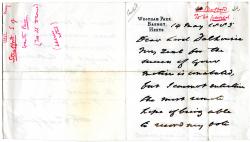
Seven letters to Lord Dalhousie, as Lord in Waiting [whip] in the House of Lords, from peers, regarding the second reading of a bill entitled 'Marriage with the Sister of a Deceased Wife'.
According to the diarist Sir Edward Walter Hamilton, the second reading of the Divorced Wife's Sister Bill caused 'great excitement'. Due to clerical opposition, the Bill did not reach the statute book until 1907, and even then in a limited form. These seven items provide an interesting glimpse into the inner workings of the Victorian legislative process. All are clear and complete, and docketed by Dalhousie in red. All in fair condition, with various degrees of aging. Letter One: Sir Thomas Henry Farrer ('S Th Farrer'); 16 July 1885; 27 Bryanston Square, on letterhead of the Athenaeum Club, Pall Mall. 12mo, 3 pp. He is enclosing a copy (not present) of a letter which he sent 'to the Spectator last year on the subject of the Deceased Wifes sister Bill. - It may possibly be of some use to you, as it is a real case - my own. | I have always felt strongly against our present law, as a gross piece of clerical tyranny: - But I feel even yet more strongly against the hypocrisy which, afraid of resting the case on its real ground of ecclesiastical authority, tries to support it by social arguments which are if possible more revolting than they are false.' While he could not put his name to 'such a letter', 'the actual experience of one who has known what a sister in law may be - is perhaps of some value'. Letter Two: Francis Needham, 3rd Earl of Kilmorey ('Kilmorey'); 16 May 1885; on letterhead of Glenmore House, Rosstrevor, County Down, Ireland. They are not 'coming up to town this season', so wish to be paired in favour of the bill. 'Kind regards from self & wife to you & Lady Dalhousie & the twins!' Letter Three: Arthur Kinnaird, 10th Lord Kinnaird ('Kinnaird'); 8 June 1885; on letterhead of 1 Pall Mall East, London, S.W. 12mo, 2 pp. He has been 'very unwell lately', and his doctor has 'forbidden my doing more than is absolutely necessary - I therefore thought I ought to obey him & stay away'. Letter Four: George Hay, 12th Earl of Kinnoull ('Kinnoull'); 27 May 1885; on letterhead of Dupplin Castle, Perth. 12mo, 2 pp. He is 'anxious to support the second reading of the bill', but as he does not 'expect to be in London at that time' he asks for a pair. Letter Five: Douglas Graham, 5th Duke of Montrose ('Montrose'); 28 May 1885; on letterhead of Buchanan Castle, Glasgow. He cannot be in his place, and asks for a pair. 12mo, 2 pp. Letter Six: George Byng, 3rd Earl of Strafford ('Strafford'); 14 May 1885; on letterhead of Wrotham Park, Barnet Herts. 16mo, 3 pp. His 'zeal for the success of your motion is unabated', but he 'cannot entertain the most remote hope of being able to record my vote [...] The discredited alternative of a Pair is my only chance of serving the cause, & perhaps, in the interval before the 2nd Reading, you may in your energetic arrangements hear of some (I hope, more convalescent) opponent with whom I might be linked.' He is sure 'Enfield' would 'assist in the search'. Letter Seven: Edward Montagu-Stuart-Wortley-Mackenzie, 1st Earl of Wharncliffe ('Wharncliffe'); 16 May 1885; British Embassy, Vienna. 12mo, 2 pp. There is 'no chance' of his being present. 'We remain here for another ten days, and then have to go down to Yorkshire'.


